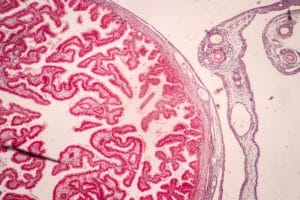
The response of the placenta to infections with malaria, toxoplasmosis and listeria has been mapped in high resolution, potentially paving the way for new treatment options. For the first time, a panoramic picture of infection pathways in the human placenta has been created that could reveal potential targets for the development of pregnancy-safe therapies against malaria, toxoplasmosis and listeria, all diseases that can cause serious pregnancy complications. Researchers from the Wellcome Sanger Institute, the University of Cambridge, the University of Dundee and collaborators have used novel ‘mini-placenta’ models to map the placenta’s response to infection in early development. This work is part of the wider Human Cell Atlas consortium, which aims to map every cell type in the human body to improve our understanding of health and disease.
Infections During Pregnancy Can Harm the Fetus
The study, published in Cell Systems, focused on the signaling pathways involved in malaria, toxoplasmosis and listeria infections, all of which can lead to pregnancy complications and miscarriage. Secondary inflammation was shown to be the cause of pregnancy complications in these infections, and it was revealed that placental immune cells likely play a role in defense against pathogens. Future work focusing on identifying potential drug targets in the signaling pathways that cause complications during infection could support the development of more targeted therapies to combat infections in early pregnancy.

Infections during pregnancy are a major global health problem affecting millions of people around the world. These infections can lead to maternal death, sepsis and pregnancy complications such as miscarriage, fetal developmental disorders, low birth weight and stillbirth. Malaria, toxoplasmosis and listeria are common infections that can lead to pregnancy complications. This is of particular concern in regions where these infections are more common. For example, in sub-Saharan Africa and parts of South East Asia where the malaria parasite Plasmodium falciparum is endemic.
During pregnancy, the placenta acts as a selective barrier that enables nutrients to be transported from the mother to the child and at the same time blocks pathogens and toxins. However, the pathogens of toxoplasmosis and listeria can pass through the placenta, and the parasite responsible for malaria can attach to the outside. The fetus is particularly vulnerable in the early stages of development as the immune response is not yet fully developed, so the fetus relies heavily on the placental barrier for protection.
Research Using “Mini-Placenta” Models Could Lead to Pregnancy-Specific Treatment of Infections
Despite the impact of infections during pregnancy, the pathways and mechanisms that these infections use to cross the placenta are poorly understood, in part due to the limitations of the laboratory models used and the differences between humans and mice. In the recent study by the Wellcome Sanger Institute and its collaborators, the team created ex vivo explant models or “mini-placentas” from human samples that allowed them to map the response to infection at single-cell resolution. The researchers identified a type of fetal immune cell, known as Hofbauer cells, that were activated in all three types of infection, but by different pathways. This is the first time that placental immune cells have been shown to play a defense role against pathogens in a human placenta model. The team found that pathogens can infiltrate these immune cells. For example, T. gondii, the parasite that causes toxoplasmosis, likely uses these immune cells to evade the ongoing immune response and spread throughout the body. They also discovered that all three infections triggered a general inflammatory response in the placenta that dysregulated placental functions. This suggests that secondary inflammation could be the cause of some pregnancy complications.
Targeting these inflammatory pathways could lead to pregnancy-specific treatment of infections, which is currently not possible. In addition, the “mini-placenta” models developed by this team can be used in future research to gain further insight into the placenta’s response to infection as well as general changes in the placenta during development. The research shows that even with pathogens that cannot cross the placenta, secondary inflammation of the immune system can be responsible for disrupting fetal development. Identifying key processes involved in the inflammatory pathway could help develop pregnancy-specific treatments that minimize this in the future.
This is the first time that placental immune cells have been shown to play a defensive role in humans during early pregnancy, and that these immune cells can be hijacked by Toxoplasma during infection. Knowing more about how the placenta’s immune system works may provide researchers with new insights into pregnancy complications. Studying the interactions between pathogens and the human placenta is incredibly difficult, so developing new models, such as the placental tissue system the researchers used, is a much-needed step forward.


